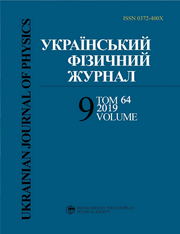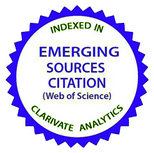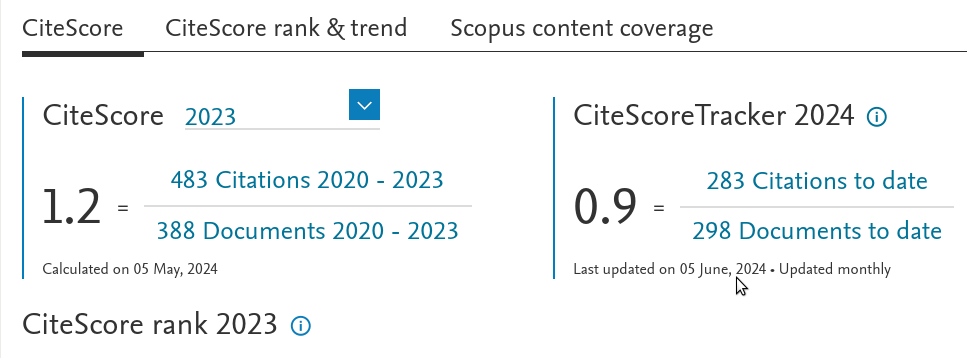Дослідження парамагнітних координаційних сполук лантаноїдів складу [LnL3 • Phen] (L = CCl3C(O)NP(O)(OCH3)2) методом ЯМР-спектроскопії на ядрах 1H та 31P
DOI:
https://doi.org/10.15407/ujpe64.9.855Ключові слова:
координацiйнi сполуки лантаноїдiв, карбациламiдофосфати, ЯМР-спектроскопiя, iзотропний хiмiчний зсувАнотація
Cинтезовано ряд координацiйних сполук лантаноїдiв з диметил-N-трихлорацетиламiдофосфатом HL (HL=CCl3C(O)N(H)P(O)(OCH3)2, лiгандом карбациламiдофосфатного (CAPh) типу) складу [LnL3 · Phen], де Phen – 1,10 фенантролiн, Ln = La, Ce, Pr, Nd, Sm, Tb, Dy, Ho, Er. Розчини лiганду HL та синтезованих на його основi комплексiв в ацетонi дослiдженi методом ЯМР 1H та 31P при кiмнатнiй температурi 298 К. Оскiльки хiмiчнi зсуви сигналiв 1H мають псевдоконтактну природу, то iзотропнi зсуви сигналiв 31Р вдалося розкласти на контактну та псевдоконтактну складовi. Було встановлено iснування у розчинi сполук [LnL3 · Phen] двох серiй комплексiв, що мають однакову будову координацiйної сфери в межах кожної серiї: Ln=Ce, Pr, Nd, Sm (L1) та Ln=Tb, Dy, Ho, Er (L2). Для цих комплексiв було розраховано значення константи надтонкої взаємодiї: 0,18 МГц (L1) та 0,13 МГц (L2).
Посилання
A.J. Roche, S.A. Rabinowitz, K.A. Cox. Efficient NMR enantiodiscrimination of bridge fluorinated paracyclophanes using lanthanide tris beta-diketonate complexes. Tetrahedron: Asymmetr. 24, 1382 (2013). https://doi.org/10.1016/j.tetasy.2013.09.024
S. Spiliadis, A.A. Pinkerton. Paramagnetic nuclear magnetic resonance study of the lanthanide complexes [Ln(SPR)3]; R=OMe, OiPr. Determination of phosphorus hyperfine coupling and solution structures. Inorg. Chim. Acta. 75, 125 (1983). https://doi.org/10.1016/S0020-1693(00)91198-8
A.V. Turov, S.P. Bondarenko, A.A. Tkachuk, V.P. Khilya. Study of the conformational mobility of substituted 2-methoxychalcones under the influence of lanthanide shift reagents. Zh. Org. Khim. 41, 51 (2005) (in Russian). https://doi.org/10.1007/s11178-005-0118-x
V.F. Zolin, L.G. Koreneva. Rare-Earth Probe in Chemistry and Biology (Nauka, Moscow, 1980) (in Russian).
M. Woods, D.E. Woessnerc, A.Dean Sherry. Paramagnetic lanthanide complexes as PARACEST agents for medical imaging. Chem. Soc. Rev. 35, 500 (2006). https://doi.org/10.1039/b509907m
M.D. Organ, R.C. Brasch. Contrast enhancing agents in NMR imaging. Annu. Rep. Med. Chem. 20, 277 (1985). https://doi.org/10.1016/S0065-7743(08)61054-4
J.A. Peters, M.S. Nieuwenhuizen, A.P.G. Kieboom, D.J. Raber. Analysis of multinuclear lanthanide induced shifts. Part 5′. The coordination polyhedron of 1 : 3 lanthanide(III)-glycolate complexes in aqueous solution. J. Chem. Soc. Dalton Trans. 3, 717 (1988). https://doi.org/10.1039/DT9880000717
V.V. Skopenko, V.M. Amirkhanov, T.Yu. Sliva, I.S. Vasilchenko, E.L. Anpilova, A.D. Garnovskii. Various types of metal complexes based on chelating B-diketones and their structural analogues. Russ. Chem. Rev. 8, 737 (2004). https://doi.org/10.1070/RC2004v073n08ABEH000909
V.M. Amirkhanov, V.A. Ovchynnikov, V.A. Trush, P. Gawryszewska, L.B. Jerzykiewicz. Powerful new ligand systems: Carbacylamidophosphates (Caph) and sulfonylamidophosphates (Saph). In Ligands. Synthesis, Characterization and Role in Biotechnology (NOVA Publishers, 2014) [ISBN: 978-1631171437].
O.O. Litsis, I.O. Shatrava, V.M. Amirkhanov, V.A. Ovchynnikov, T.Yu. Sliva, S.V. Shishkina, V.V. Dyakonenko, O.V. Shishkin, V.M. Amirkhanov. New carbacylamidophosphates (CAPh) and CAPh-containing coordination compounds: structural peculiarities. Struct. Chem. 27, 341 (2016). https://doi.org/10.1007/s11224-015-0701-x
N.S. Kariaka, J.A. Rusanova, S.S. Smola, S.V. Kolotilov, K.O. Znovjyak, M. Weselski, T.Yu. Sliva, V.M. Amirkhanov. First examples of carbacylamidophosphate pentanuclear hydroxo-complexes: Synthesis, structure, luminescence and magnetic properties. Polyhedron. 106, 44 (2016). https://doi.org/10.1016/j.poly.2015.12.052
O. Litsis, V. Ovchynnikov, T. Sliva, S. Shishkina, V. Amirkhanov. Lanthanide coordination compounds with monodentate coordinated B-diketone heteroanalogue-(2,2,2-trichloro-N-(dipiperidin-1-yl-phosphoryl)acetamide: synthesis and spectral investigations. Chem. J. Moldova 13, 15 (2018). https://doi.org/10.19261/cjm.2017.466
V. Amirkhanov, A. Rauf, T.B. Hadda, V. Ovchynnikov, V. Trush, M. Saleem, M. Raza, T. Rehman, H. Zgou, U. Shaheen, T. Farghaly. Pharmacophores modeling in terms of prediction of theoretical physico-chemical properties and verification by experimental correlations of carbacylamidophosphates (CAPh) and sulfanylamidophosphates (SAPh) tested as new carbonic anhydrase inhibitors. Mini-Rev. Med. Chem. 19, 20 (2019). https://doi.org/10.2174/1389557519666190222172757
I.I. Grynyuk, S.V. Prylutska, N.S. Kariaka, T.Yu. Sliva, O.V. Moroz, D.V. Franskevych, V.M. Amirkhanov, O.P. Matyshevska, M.S. Slobodyanik. Computer prediction of biological activity of dimethyl-n-(benzoyl)amidophosphate and dimethyl-n-(phenylsulfonyl)amidophosphate, evaluation of their Cytotoxic activity against leukemia cells invitro. Ukr. Biochem. J. 87, 154 (2015). https://doi.org/10.15407/ubj87.06.154
Iu. Shatrava, V. Ovchynnikov, K. Gubina, S. Shishkina, O. Shishkin, V. Amirkhanov. Varieties in structures of Co(II), Ni(II) and Cu(II) coordination compounds based on dimethyl pyridine-2-ylcarbamoylphosphoramidate. Struct. Chem. 27, 1413 (2016). https://doi.org/10.1007/s11224-016-0761-6
S.J. Lyle, Md.M. Rahman. Complexometic titration of yttrium and lanthanoids. Talanta 10, 1177 (1963). https://doi.org/10.1016/0039-9140(63)80170-8
V.M. Amirkhanov, V.A. Trush. Properties and structure of dimethyl ester of trichloroacetyl-amidophosphoric acid. Zh. Org. Khim. 7, 1120 (1995) (in Russian).
J. Cybin'ska, J. Legendziewicz, V. Trush, R. Reisfeld, T. Saraidarov. The orange emission of single crystals and solgels based on Sm3+ chelates. J. Alloy. Compd. 451, 94 (2008). https://doi.org/10.1016/j.jallcom.2007.04.088
M. Puchalska, I. Turowska-Tyrk, V. Trush, J. Legendziewicz. Structural characteristic and luminescence properties of first known example of a pair of europium(III) complexes of phosphoroazo-derivative of B-diketone with inner and both inner and outer sphere 2,2′-bipyridine. J. Alloy. Compd. 451, 264 (2008). https://doi.org/10.1016/j.jallcom.2007.04.183
V. A. Trush, O.O. Litsis, T.Yu. Sliva, V.M. Amirkhanov. Heteroleptic lanthanide complexes with the CAPh-type ligand dimethyl-N-trichloracetylamidophosphate. Visn. Odes. Nats. Univ. Khim. 22, 62 (2017). https://doi.org/10.18524/2304-0947.2017.2(62).102214
G. Oczko, J. Legendziewicz, V. Trush, V. Amirkhanov. X-ray analysis and excited state dynamics in a new class of lanthanide mixed chelates of the type LnPhB3·Phen(Ln = Sm, Eu, Gd, Tb). New J. Chem. 27, 948 (2003). https://doi.org/10.1039/B211044J
J. Reuben, D. Fiat. Nuclear magnetic resonance studies of solutions of the rare earth ions and their complexes. J. Chem. Phys. 51, 4909 (1969). https://doi.org/10.1063/1.1671883
K.A. Gschneidner, J.-C.G. Bunzli, V.K. Pecharsky. Handbook on the Physics and Chemistry of Rare Earths, (Elsevier, 2003) [ISBN: 978-0-444-51323-6].
A.M. Funk, K.-L.N. A. Finney, P. Harvey, A.M. Kenwright, E.R. Neil, N.J. Rogers, P.K. Senanayake and D. Parker. Critical analysis of the limitations of Bleaney's theory of magnetic anisotropy in paramagnetic lanthanide coordination complexes. Chem. Sci. 6, 1655 (2015). https://doi.org/10.1039/C4SC03429E
B.B. Bleaney. Nuclear magnetic resonance shifts in solution due to lanthanide ions. J. Magn. Reson. 8, 91 (1972). https://doi.org/10.1016/0022-2364(72)90027-3
R.S. Drago, J.I. Zink, R.M. Richman, W.D. Perry. Theory of isotropic shifts in the NMR of paramagnetic materials: Part I. J. Chem. Educ. 51, 371 (1974). https://doi.org/10.1021/ed051p371
A.A. Pinkerton, W.L. Earl. A nuclear magnetic resonance investigation of bis(O,O′-diethyldithiophosphato)-complexes of the lanthanids: Separation of contact and pseudo-contact contributions to the chemical shifts. J. Chem. Soc. Dalton Trans. 3, 267 (1978). https://doi.org/10.1039/DT9780000267
L. Fusaro. An 17O NMR study of diamagnetic and paramagnetic lanthanide-tris(oxydiacetate) complexes in aqueous solution. Magn. Reson. Chem. 56, 1168 (2018). https://doi.org/10.1002/mrc.4781
K. Djanashvili, J.A. Peters. How to determine the number of inner-sphere water molecules in lanthanide(III) complexes by 17O NMR spectroscopy. A technical note. Contr. Media Mol. Imag. 2, 67 (2007). https://doi.org/10.1002/cmmi.132
Downloads
Опубліковано
Як цитувати
Номер
Розділ
Ліцензія
Ліцензійний Договір
на використання Твору
м. Київ, Україна
Відповідальний автор та співавтори (надалі іменовані як Автор(и)) статті, яку він (вони) подають до Українського фізичного журналу, (надалі іменована як Твір) з одного боку та Інститут теоретичної фізики імені М.М. Боголюбова НАН України в особі директора (надалі – Видавець) з іншого боку уклали даний Договір про таке:
1. Предмет договору.
Автор(и) надає(ють) Видавцю безоплатно невиключні права на використання Твору (наукового, технічного або іншого характеру) на умовах, визначених цим Договором.
2. Способи використання Твору.
2.1. Автор(и) надає(ють) Видавцю право на використання Твору таким чином:
2.1.1. Використовувати Твір шляхом його видання в Українському фізичному журналі (далі – Видання) мовою оригіналу та в перекладі на англійську (погоджений Автором(ами) і Видавцем примірник Твору, прийнятого до друку, є невід’ємною частиною Ліцензійного договору).
2.1.2. Переробляти, адаптувати або іншим чином змінювати Твір за погодженням з Автором(ами).
2.1.3. Перекладати Твір у випадку, коли Твір викладений іншою мовою, ніж мова, якою передбачена публікація у Виданні.
2.2. Якщо Автор(и) виявить(лять) бажання використовувати Твір в інший спосіб, як то публікувати перекладену версію Твору (окрім випадку, зазначеного в п. 2.1.3 цього Договору); розміщувати повністю або частково в мережі Інтернет; публікувати Твір в інших, у тому числі іноземних, виданнях; включати Твір як складову частину інших збірників, антологій, енциклопедій тощо, то Автор(и) мають отримати на це письмовий дозвіл від Видавця.
3. Територія використання.
Автор(и) надає(ють) Видавцю право на використання Твору способами, зазначеними у п.п. 2.1.1–2.1.3 цього Договору, на території України, а також право на розповсюдження Твору як невід’ємної складової частини Видання на території України та інших країн шляхом передплати, продажу та безоплатної передачі третій стороні.
4. Строк, на який надаються права.
4.1. Договір є чинним з дати підписання та діє протягом усього часу функціонування Видання.
5. Застереження.
5.1. Автор(и) заявляє(ють), що:
– він/вона є автором (співавтором) Твору;
– авторські права на даний Твір не передані іншій стороні;
– даний Твір не був раніше опублікований і не буде опублікований у будь-якому іншому виданні до публікації його Видавцем (див. також п. 2.2);
– Автор(и) не порушив(ли) права інтелектуальної власності інших осіб. Якщо у Творі наведені матеріали інших осіб за виключенням випадків цитування в обсязі, виправданому науковим, інформаційним або критичним характером Твору, використання таких матеріалів здійснене Автором(ами) з дотриманням норм міжнародного законодавства і законодавства України.
6. Реквізити і підписи сторін.
Видавець: Інститут теоретичної фізики імені М.М. Боголюбова НАН України.
Адреса: м. Київ, вул. Метрологічна 14-б.
Автор: Електронний підпис від імені та за погодження всіх співавторів.

















